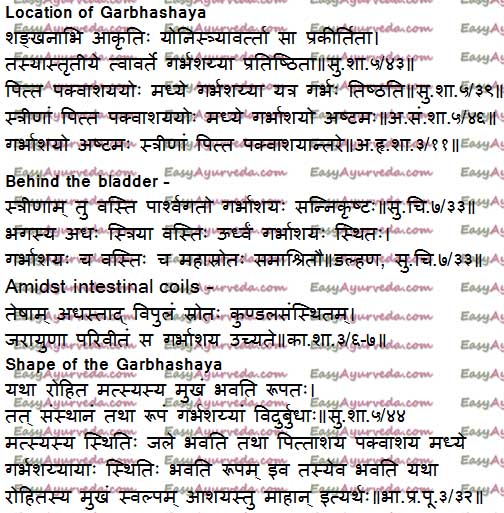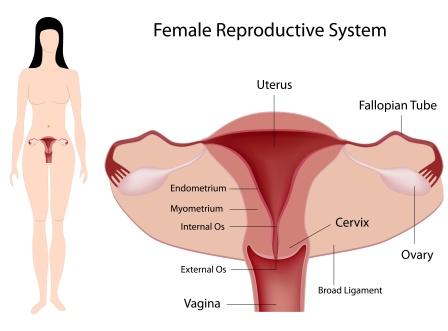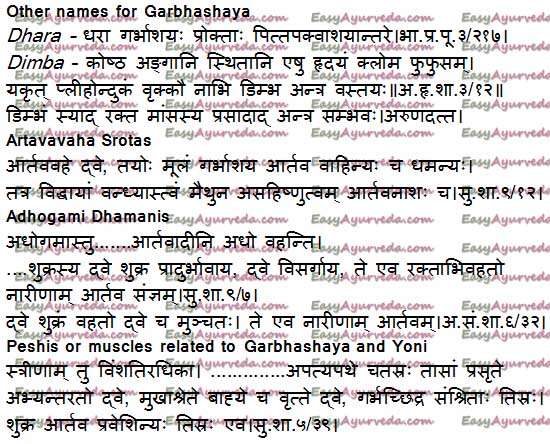Garbhashaya – Anatomy Of Uterus, Ayurvedic Perspective
By Dr Raghuram Y.S. MD (Ay) & Dr Manasa, B.A.M.S
Garbhashaya means uterus. In common language it is called womb. It is a place where fetus grows into maturity and is delivered at term as new born infant.
Table of Contents
Introduction
Garbhashaya is a word made up of two terms i.e.
Garbhashaya = Garbha + Ashaya
Garbha = fetus
Ashaya = residence,
Garbhashaya is one of ashayas and is found only in women. It is 8th ashaya. Other 7 ashayas are present in both male and female.
Related Reading – Ashaya – Meaning, Types, Location, Utility
Sanskrit sloka

Location
Location of Garbhashaya
In between small and large intestines –
According to Sushruta, Garbhashaya is located in 3rd avarta i.e. 3rd circle of yoni.
Uterus is anatomically located between pittashaya (gall bladder or small intestine) and pakwashaya i.e. large intestine. It provides space for growing fetus all through 9 months of its growth and maturity.
Though pittashaya is most often equated with gall bladder but in this context term shall be correlated with small intestine, which is seat of pittadhara kala.
Uterus is above sigmoid colon, behind urinary bladder and multiple coils of small intestine rest upon uterus.
It is covered by peritoneum and is an intra-abdominal structure.
This has been explained in a similar way by Dalhana and Kashyapa too.
Read – Anna Visha – When Food Turns Toxic: Causes, Symptoms

Behind the bladder –
Sushruta and Vagbhata also said that uterus is located behind urinary bladder.
Dalhana says that it is hollow inside like mouth of rohita fish, urinary bladder is behind bhaga i.e. vulva and uterus is above bladder.
Dalhana has further included both uterus and urinary bladder in mahasrotas i.e. part of great channel of body.
Amidst intestinal coils –
According to Kashyapa, uterus is located amidst vipula srota kundala i.e. coils of intestine covered with jarayu (peritoneum).
Shape of Garbhashaya
Uterus resembles shape of rohita matsya mukha or mouth of rohita fish.
Dalhana, commentator of Sushruta Samhita explains meaning of rohita matsya mukha as ‘the structure or organ having narrow opening like that of mouth of rohita fish and includes a wider hollow space within.
Read – Kala Shareera: Concept, Definition, Types, Clinical Relevance
This simile of uterus with mouth of rohita fish might have been given probably due to two reasons.
– Similarity in shape – both fish and uterus are roughly triangular in shape and also hollow within. Mouth of fish is flat below and slightly convex above.
Similarly anterior wall of uterus is slightly flat, while its posterior wall is slightly convex.
– Lips of fish are fleshy and hanging. Opening of uterus i.e. cervix of uterus appears to look like mouth of rohita fish.
Opening of cervix continues inwards as cervical canal which continues with a wider space of the uterine cavity.
Similar explanation of shape of uterus has been given in Bhavaprakasha. Text says Garbhashaya is of shape of rohita fish. Just like rohita fish is located in sea being surrounded by water on all sides, uterus is interposed between coils of small and large intestines.
Just like rohita fish, in spite of having small mouth encloses a large cavity within it, uterus also has a small mouth (cervix) but has a large hollow cavity within it (uterine cavity).
Read – Ayurvedic Food Recipe For Kidney, Bladder Cleanse: Ashtaguna Manda
Other names for Garbhashaya

Dhara –
Bhavaprakasha has elsewhere given a term called dhara for garbhashaya. He writes ‘the dhara located between pittashaya and pakwashaya is called garbhashaya’.
Read – Immunity In Ayurveda: Concept, Diet, Herbs, Medicines, Exercise
Dimba –
Vagbhata has enumerated an organ named dimbha amongst structures of koshta i.e. visceral space. Arunadatta, the commentator of Ashtanga Sangraha says that dimbha is made up of blood and flesh and is derived from intestines.
Meaning of word dimba found explained in Ayurvedic texts is not precisely known. It is used to describe ovum and also ovaries. Due to absence of specific structural description of dimba and its presence in both sexes, it is difficult to compare it to any structure.
Read – Importance Of Marma: Need for study
In Amarakosha, dimba is translated as child.
Another dictionary, Vaidyaka Sabdasindhu explains dimba as urinary bladder or uterus.
In context of females, this can be considered as uterus since dimba is made up of flesh and is a good vascular structure, just like uterus and is situated amongst intestinal coils.
Artavavaha Srotas
Artava vaha srotas means channels or passages which carry menstrual blood.
They are two in number and have their roots in uterus and arteries or vessels carrying menstrual blood. Injury to these structures produces infertility, dyspareunia and amenorrhea.
Adhogami Dhamanis
Channels tending downwards carry menstrual blood in a downward direction.
Males have two arteries for formation of semen and two for its secretion.
Analogous to these, women have 2 arteries for formation and 2 arteries for excretion of menstrual blood.
These arteries can be compared to ovarian arteries responsible for formation of ovum and ovarian hormones and uterine arteries responsible for excretion of menstrual blood.
Read – Marma Shaareera: Definition, Composition: Vital Points of The Body
Marma
Marmas or vital organs and spots related to Garbhashaya
Rectum and urinary bladder are vital organs located in vicinity of uterus.
Peshis or muscles related to Garbhashaya and Yoni
Word peshi in Ayurveda has been used to denote fascia, muscles, tendons and ligaments in various contexts.
Muscles of female reproductive system have been classified under four subgroups.
They are 10 in number.
– Apatyapatha mukha ashrita peshi (bahirmukha vartulakara peshi) –
Outer circular muscles, 1 in number
Compared to muscle fibres of bulbocavernosus muscles encircling introitus
– Apatyapatha abhyantara peshi –
Muscles spreading inside vaginal canal, 2 in number
Compared to anterior and posterior vaginal wall or muscular layer and pubo-cervical along with recto-vaginal fascia
– Garbha chidra samstitha peshi –
3 in number
Compared to uterosacral, cardinal and pubocervical ligaments or fundus, corpus and isthmus of uterus
– Shukra artava praveshini peshi –
Muscles responsible for entry of sperms and ovum into uterine cavity.
3 in number- 1 cervix of uterus (for entry of semen) and 2 fallopian tubes (for entry of ovum)
Read – Dhatu Mala: Tissue Waste Products: Ayurveda perspective
Analogous muscles –
Analogous to penis – clitoris, bhagashishnika
Analogous to scrotum – labia majora, bhaga
Click to Consult Dr Raghuram Y.S. MD (Ayu) – Email / Skype









